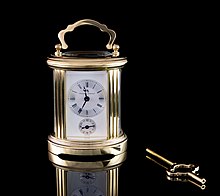| This article needs additional citations for verification. Please help improve this article by adding citations to reliable sources. Unsourced material may be challenged and removed. Find sources: "Carriage clock" – news · newspapers · books · scholar · JSTOR (January 2016) (Learn how and when to remove this message) |


A carriage clock is a small, spring-driven clock, designed for travelling, developed in the early 19th century in France. The first carriage clock was invented by Abraham-Louis Breguet for the Emperor Napoleon in 1812. The case, usually plain or gilt-brass, is rectangular with a carrying handle and often set with glass or more rarely enamel or porcelain panels. A feature of carriage clocks is the platform escapement, sometimes visible through a glazed aperture on the top of the case. Carriage clocks use a balance and balance spring for timekeeping and replaced the larger pendulum bracket clock. The factory of Armand Couaillet, in Saint-Nicolas d'Aliermont, France, made thousands of carriage clocks between 1880 and 1920.
A carriage clock has in the past been a traditional gift from employers to retiring or long-serving staff. However, in modern times, with changing work patterns and changing desires, this is much less the case.
Sources and references
- Charles Allix and Peter Bonnert, Carriage Clocks. Their history and development, Antique Collector's club, 1974
- Emmanuelle Cournarie, La mécanique du geste, trois siècles d'histoire horlogère à Saint-Nicolas d'Aliermont, Édition PTC-Les Falaises, 2011 (French)
- Lolita Delesque and Marianne Lombardi, Armand Couaillet, horloger et inventeur de génie, Musée de l'horlogerie, juin 2013, 44p (French)
- Crawford, Robert (25 November 2013). "Top five long-service awards for employees". Employee Benefits.
- "Time runs out for carriage clock". BBC News. 24 February 2006.
External links
This technology-related article is a stub. You can help Misplaced Pages by expanding it. |